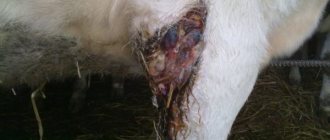Tuberculosis is a disease of infectious etiology, which affects both people and four-legged pets equally. This terrible disease is caused by aerobic bacteria from the genus Mycobacterium. There are four types of tuberculosis bacillus: bovine, human, mouse and avian. The first two varieties pose a particular threat to dogs.
Progressing in the pet’s body, harmful mycobacteria can affect almost all vital organs. In advanced forms, the disease leads to the death of the animal. The article will provide a detailed analysis of a disease such as tuberculosis in dogs, listing its causes, symptoms, treatment methods and preventive measures.
Causes of the disease
Experts have determined that a dog can get tuberculosis due to reasons such as:
- The owner of the animal has an infection. In the open form of the disease, bacteria can easily be transmitted by airborne droplets from owner to pet. Veterinarians consider this cause to be one of the most common, since regular contact occurs between an infected person and a furry friend, increasing the risk of infection.
- The dog lives or walks in close proximity to the tuberculosis clinic. Especially often those individuals who walk without a leash are infected. By accidentally running into the territory of the dispensary, they can come into contact with patients, and the owner will not even suspect it. In addition, bacteria are aerobic in nature, which means that a pet can pick up an infectious agent simply from its habitat by sniffing infected grass or a tree branch.
- Infection with tuberculosis can equally well occur through food that contains bacteria. In veterinary medicine, this route of mycobacteria entering the body of animals is called nutritional. It becomes feasible after the dog eats the meat of a sick representative of the fauna, or licks their sputum containing tubercles, as well as while feeding the puppies with the milk of a sick mother.
- A significant weakening of the immune system due to the pet living in unfavorable, unsanitary conditions also provokes the development of tuberculosis in dogs.
An important question that many pet owners ask is, is it possible to become infected with tubercle bacilli from a dog? Unfortunately, the answer to this is yes. Indeed, the infection is transmitted both from person to pet and from pet to person. Therefore, veterinarians recommend that when the first suspicion appears that a dog has tuberculosis, immediately take it to a veterinary clinic, and the owner rush to undergo all clinical tests in the hospital. The problem is too serious to be blithely ignored.
[custom_ads_shortcode1]
Can an animal become infected?
Infection of dogs occurs through airborne droplets and nutrition. The source of infection is sick animals or humans, as well as products from sick individuals. A person is dangerous for a dog in the so-called open form of the disease. During this period, mycobacteria enter the environment with sputum.
Dairy products are often the source of Koch's wand for furry pets. Whole milk from a sick cow is especially dangerous. Dogs can become infected by eating contaminated meat products or licking sputum from a sick dog. Puppies in most cases become infected from their mother through milk contaminated with mycobacteria.
Forms of the disease
Doctors have found that this disease can manifest itself in two characteristic forms. Let's look at each of them in more detail:
- Latent: it cannot be diagnosed based on observations of symptoms, since the infection practically does not manifest itself in the host’s body. It is most often discovered by chance using x-rays. Treatment assumes a positive prognosis.
- Generalized form: it is characterized by extensive lesions of the gastrointestinal tract, as well as pathological processes in the respiratory and genitourinary systems. If the infected dog is not treated with medication on time, the disease will develop into a chronic condition. There is a high risk that the pet will die.
Owners must clearly understand that during the incubation period, when bacteria are just settling into the animal’s body, they do not manifest themselves in any way. The only thing worth paying attention to is that the dog began to get tired quickly and also sleeps a lot, although he used to love to play with his owner. At the end of the incubation period, the disease will enter the initial stage, expressed in such signs as decreased appetite, a slight increase in the dog’s body temperature, and unreasonable weight loss.
[custom_ads_shortcode2]
Stages of the disease
The course of the disease is divided into the initial period and the peak stage. In the initial period, there are practically no noticeable symptoms, and the infection itself is not dangerous to others. At this time, bacteria actively spread throughout the pet’s body. As for the stage of the height of tuberculosis, then in it the pet becomes a walking carrier of the infectious agent. By coughing, he infects the air, food and all objects in his environment. It is important to understand that the rate of development of the disease and the intensity of its manifestation directly depends on the dog’s immunity, its age and conditions of detention.
[custom_ads_shortcode3]
Symptoms of the disease
Symptoms of tuberculosis may not appear at all for a period of time ranging from 14 to 28 days. But doctors are convinced that, despite the smooth progression of the disease, an attentive owner is able to determine that his barking friend is sick. You need to worry about his health if:
- the dog developed severe shortness of breath, accompanied by bloody discharge, after minor physical exertion;
- the animal began to suffer from diarrhea, and blood could be found in its stool. This is a sign of gastrointestinal damage;
- the submandibular lymph nodes are inflamed; when palpated, their obvious enlargement and hardening are felt. Over time, ulcers and purulent abscesses may appear in this problem area;
- accumulation of fluid in the abdominal cavity and jaundice provoke bloating of the dog’s abdomen;
- attacks of fever, fever, profuse nasal discharge;
- significant loss of strength, apathy.
The above symptoms are characteristic of the chronic form of tuberculosis; as for the latent form, there are practically no signs of the disease. The dog's appetite decreases, its fur becomes dull, it gets tired quickly and prefers to lie in one place. According to statistics, this form is discovered mainly after opening.
[custom_ads_shortcode1]
Epizootological data
Its causative agent is a microorganism called “Koch bacillus,” which belongs to the genus of mycobacteria. This genus also has several pathological species that are causative agents of tuberculosis in the vast majority of warm-blooded animals:
- 1. Mycobacterium tuberculosis - human;
- 2. Mycobacterium microti - mouse;
- 3. Mycobacterium avium - avian;
- 4. Mycobacterium bovis - bovine.
Any of these mycobacteria can cause tuberculosis, but dogs are most often susceptible to bovine and human pathogens. The peculiarity of this disease is that it has a chronic course and worsens during periods of weakened immunity.
The Koch bacillus, which contributes to infection, is excreted from the body mainly with saliva and sputum and, depending on the location, is present from several months to several years. This mycobacterium is resistant to low temperatures and disinfectants.
Infection of an animal occurs by airborne droplets through the digestive tract when eating contaminated foods or through contact with damaged skin during mating. After the infection enters the body, the mycobacterium settles in the lymph nodes and then enters the lungs and other organs along with the bloodstream.
An inflammatory process develops, as a result of which avascular grayish nodes called tubercles are formed in the organs. The incubation period lasts from two to six weeks depending on the animal's immunity. After a period of time, a connecting capsule appears around the perimeter of the node, and the internal tissue dies, turning into powder.
Symptoms of tuberculosis disease in dogs
As a rule, it occurs latently or chronically. The most common and easily noticeable symptoms include:
- fever;
- weight loss;
- weakness;
- the coat is tousled or thinning;
- difficult-to-heal ulcers on the skin;
- ascites - the presence of fluid in the abdominal cavity;
- enlarged lymph nodes;
- wheezing, cough and shortness of breath;
- nasal discharge and bloody sputum;
- loose stools, diarrhea;
- inflammation of the lymph nodes in the oral cavity;
- dehydration, thirst;
- frequent urination;
- lack of mood.
If you notice at least one symptom in your pet, you need to contact a veterinary hospital.
Diagnosis of the disease
Timely diagnosis significantly increases the chances of successful treatment of a sick animal. To make an accurate diagnosis, veterinarians carry out a set of procedures to differentiate tuberculosis from other infectious diseases. Research includes taking blood for general and biochemical analysis, x-raying the dog’s lungs and giving him a subcutaneous injection of dry tuberculin. The essence of the last procedure is that if after two days the animal does not react to the injection with an allergy, then it definitely suffers from tuberculosis.
[custom_ads_shortcode2]
Diagnostics
Making an accurate diagnosis when tuberculosis is suspected is quite difficult. The “mantoux” tests familiar to humans since childhood do not work on dogs, so a whole series of laboratory tests have to be carried out, many of which take a lot of time.
A general and biochemical blood test is required to determine the patient’s condition at the time of contacting the clinic. X-rays are also taken almost immediately. If the lungs are affected, it will help identify tuberculous cavities. However, the image of this disease is too similar to lung cancer, with which they are often confused, so no veterinarian will make a diagnosis based on this method alone.
If infection with mycobacteria is suspected, PCR is performed or a culture of mycobacteria taken from the patient is grown in a nutrient medium. But this requires at least a month, in which case the diagnosis is made posthumously.
After contacting the clinic with a suspicion of such a terrible diagnosis, the animal is immediately isolated, as it is dangerous to humans.
In the vast majority of cases, euthanasia is carried out, since the chances of recovery are extremely low. Sometimes veterinarians take on treatment and therapy. However, it should be remembered that a relapse is inevitable, since after recovery the dog remains a carrier of the pathogen.
Treatment of the disease
First of all, a pet suspected of having tuberculosis must be immediately isolated. Therefore, he is placed in a veterinary hospital under the supervision of qualified specialists. If the pathology manifests itself in a mild form, then doctors prescribe the patient a complex of medications, which include Isoniazid, Streptomycin and Rifampicin. Their effect is enhanced by taking antibiotics such as Tetramisole and Levomycetin.
In addition to pharmaceutical therapy, the owner must ensure that his dog is properly fed. Enrich your dog's diet with food rich in vitamins and microelements. This will reduce the harm caused to the body by drugs and strengthen the immune defense.
It is important to understand that the dog will have to be treated for 1 to 2 years in a row, and the veterinarian can give a positive prognosis only if the disease was identified promptly. And even then, the pet will remain a potential carrier of the tuberculosis bacillus for the rest of its life. If the dog has been diagnosed with a generalized form of the disease, then the best option is euthanasia, since medications are powerless in this case.
[custom_ads_shortcode3]
Prevention measures
Veterinarians have developed a number of recommendations that allow owners of four-legged pets to protect them from the risk of infection with the tuberculosis bacillus. These include:
- Careful care of the animal, including provision of decent living conditions and regular hygiene. Make sure your pet always has clean and dry bedding. Avoid excessive humidity in the room and drafts, which can cause your dog to freeze. Dilute his diet with vegetables and fruits.
- Try to ensure that the dog does not come into contact with stray tribesmen. Organize your walk in such a way that your route does not run near tuberculosis dispensaries.
- Once every six months, after consultation with a specialist, support your dog’s immunity with vitamin complexes.
- Avoid feeding your dog dairy and meat products that make you suspicious. This is especially true for products purchased on the market.
- Have a routine examination with your veterinarian three times a year.
Finally, I would like to say that tuberculosis is one of the most serious and dangerous diseases that a pet can contract. Its danger is that a complete cure is almost impossible. The animal will forever remain a potential carrier of infection, threatening the health of both the owner and his family members.
In most cases, veterinarians advise immediate euthanasia. If this option is not suitable for the owners, then they take on a huge responsibility, because for the rest of the dog’s life they will have to carefully monitor it, reacting to the slightest signs of relapse. However, there is no need to despair, because preventive measures to prevent the disease are not at all difficult to implement.
Tuberculosis in dogs is an infectious disease. It is characterized by the presence of a large number of tubercles of different sizes in the affected organs. A dog of any breed or age, both stray and domestic, can get sick. Therefore, it is very important to know what this phenomenon is, how to protect yourself from it or quickly get rid of it.
[custom_ads_shortcode1]
Forms of tuberculosis in animals
In veterinary practice, there are two forms of a dangerous disease - latent and generalized. With a latent variety of the disease, characteristic foci of encapsulated mycobacteria are detected only during radiographic examination. There are no clinical signs.
In rare cases, the owner may notice increased fatigue in the pet. The prognosis for the latent form of tuberculosis in dogs is favorable. A strong immune system blocks the infectious agent and prevents it from spreading throughout the body.
In the generalized form of the disease, mycobacteria penetrate through the blood and lymph into the internal organs and intestines. The respiratory, digestive and genitourinary systems are most often affected. The generalized form of tuberculosis has an unfavorable prognosis for the pet and ends in death from exhaustion.
Do dogs get tuberculosis?
Mycobacterium bovis is the bacterium that is most often the causative agent of the disease. This microorganism is very viable; in a natural environment, for example, in soil, it can be active for up to 5 years. Frozen for up to 12 months and on your pet's rug for up to 24 months. The disease is transmitted to dogs mainly by airborne droplets. It develops when the body is exposed to aerobic mycobacteria with an incubation period of several weeks. The disease itself, in addition to the above Mycobacterium bovis (bovine), can be caused by the following types of tubercle bacilli:
- bird;
- mouse;
- human.
As already mentioned, the bacterium is extremely viable; antiseptics are not afraid of it.
[custom_ads_shortcode2]
Epizootological data and causes of occurrence
The development of the disease occurs due to the influence of aerobic mycobacteria on the body, the incubation period of which can reach several weeks.
The tuberculosis bacillus comes in several varieties:
- bird;
- bullish;
- human;
- mouse
The bacteria of this disease are resistant to alcohol-containing solutions, chemicals and reagents. Dogs are most susceptible to the human and bovine varieties of the described pathology. In addition to airborne transmission, your pet can become infected through the digestive tract.
Human and bovine tubercle bacilli most often develop in the body of dogs.
Bacteria often enter the animal’s body along with infected meat or dairy products. Infection can also occur through bedding, pet care items, and wounds on the skin. It is possible for a puppy to become infected while nursing a sick mother. Experts do not exclude the risk of infection of the pet during mating.
There are a number of factors that increase the risk of spreading the disease:
- lack of balanced nutrition;
- poor living conditions;
- failure to comply with personal hygiene rules.
A pet with a weakened immune system is most susceptible to the occurrence and spread of tuberculosis, since its body is unable to fight the pathogen.
Important. It may take several weeks from the moment of infection to the visible manifestations of symptoms, and the development of the disease often continues for several months.
How dogs become infected with tuberculosis: causes
A person can get sick from a dog, and vice versa. In addition to airborne droplets, the pathogen can enter the dog through food. There are other quite common variants of infection:
- rug;
- microwounds;
- feeding a puppy by an infected mother;
- mating.
The likelihood of infection increases if the following factors are present:
- poor or unhealthy diet;
- keeping an animal in poor conditions without proper care.
The risk group primarily includes animals with weakened immune systems.
[custom_ads_shortcode3]
Reasons for the development of the disease
Veterinary specialists primarily consider inadequate living conditions to be factors that provoke the disease. Damp, cold, unventilated rooms help reduce the body's natural resistance to pathogenic microorganisms, including Koch's bacillus.
An unbalanced diet, the same type of feeding without taking into account the physiological need for proteins, a deficiency of vitamins and mineral nutrients in foods reduces the body's defenses and provokes infection with mycobacteria.
Long-term observations show that stray dogs and individuals living in shelters are most susceptible to the disease. Exhausted, sick and old animals are also at risk.
Forms of the disease, their characteristics
There are 2 main forms:
- Generalized – the dog’s digestive, respiratory, reproductive and urinary systems are affected. Quite often this form becomes chronic, with a high probability of death.
- Latent - not clinically determined; the basis for diagnosis can only be an x-ray. With timely and correct treatment, the chances of recovery are high.
[custom_ads_shortcode1]
Symptoms of the disease
During incubation, the disease may not manifest itself at all. The only sign will be constant fatigue of the animal, rapid fatigue. During the development of the disease, you may notice the following signs:
- temperature increase;
- poor appetite;
- weight loss.
Important! If tuberculosis is diagnosed, the dog should be isolated from household members as quickly as possible, and they, in turn, should be examined by a phthisiatrician.
[custom_ads_shortcode2]
Diagnosis of the disease
In order to identify the disease, the veterinarian performs the following procedures:
- The dog is given tuberculin in dry form under the skin. If after 48 hours no allergic reaction is observed, then the animal has a tuberculosis bacillus in its body.
- An x-ray of the lungs is prescribed.
- A blood biochemistry test is performed.
- They take a sample for bacterial culture.
The disease develops in stages. At the first stage, the course of the disease occurs in a latent form. At this time, the animal does not pose a danger to others; it cannot infect anyone.
The period of intensive development is the most dangerous, since at this time the likelihood of infecting others is highest. The dog coughs, bacteria settled in the lungs enter the surrounding air and settle wherever possible. How the disease develops, the severity and speed of its course, is directly influenced by the general condition of the dog, its age, and the conditions in which the animal is kept.
[custom_ads_shortcode3]
Treatment of the disease
An animal diagnosed with tuberculosis should be treated exclusively in a clinical setting, in strict isolation. In case of a mild form of the disease, the veterinarian prescribes tablets. Usually these are Isoniazid, Rifampicin and Streptomycin. Anti-tuberculosis drugs are supplemented with antibiotics - “Levomycin” or “Tetramizole”. In addition to treatment, the goal of which is to suppress the disease, a course of vitamins and microelements is prescribed, aimed at supporting the animal’s immunity, as well as helping the body recover as quickly as possible. Much attention should be paid to nutrition - it should be of high quality and the freshest. This is one of the elements of successful treatment. Treatment can be very long (more than one year), success directly depends on early diagnosis of the disease. In the case of diagnosing a generalized form, the use of anti-tuberculosis drugs does not give the desired result. In this case, doctors generally suggest euthanizing the animal.
Important! A sick animal may sometimes try to breathe less frequently. It does this due to the acute course of the disease in the lungs. In such cases, pleurisy may develop.
[custom_ads_shortcode1]
Diagnosis of the disease
If you suspect you have tuberculosis, go to the hospital immediately. The sooner doctors detect the disease, the safer your loved ones will be, and the easier the disease will progress.
Tests to identify the disease:
- Clinical blood test - doctors pay attention to the number of leukocytes and neutrophils.
- General urine analysis.
- Sputum analysis - due to the low detection rate, sputum must be taken 3 times early in the morning.
- X-ray image – a complete image of the lungs in segments.
- Mantoux reaction - the presence of infection is determined by the size of the papule.
To ensure the reliability of the information, it is necessary to take a biochemical blood test, but this will be decided by the doctor.
Return to contents
Prevention of tuberculosis in dogs
Tuberculosis is an extremely serious disease. In this regard, it is necessary to follow some rules in order not to become infected:
- create proper living conditions for the animal, sanitary conditions and proper nutrition;
- avoid contact with infected dogs, do not walk near tuberculosis dispensaries where people are being treated;
- 2-4 times a year, carry out immuno-strengthening therapy using vitamins that the veterinarian will prescribe specifically for your dog;
- exclude meat and dairy products of dubious origin from the animal’s diet;
- Check with a veterinarian every 6 months.
In the case of any infectious disease, it is necessary to take its treatment as seriously as possible in order to minimize damage to the animal’s immune system. Strong immunity will give a chance to avoid relapse of the disease.
If the disease is diagnosed early enough, the correct treatment is prescribed, and you strictly follow the doctor’s recommendations, the chances of recovery will be quite high. But even in this case, you should be patient, since treatment takes several years. And do not forget that even after successful treatment, the animal remains susceptible to the disease throughout its life.
[custom_ads_shortcode2]
Treatment of tuberculosis in dogs
It is worth immediately noting that it is advisable to treat a pet with tuberculosis only if the disease is at an early stage. If the disease has progressed to a more severe or overt form, the animal is usually euthanized.
If the disease has just begun, combination treatment is allowed. Antibiotics are prescribed in the form of rifampicin, streptomycin, isinazid. Immunomodulators are also recommended. The use of globulins is allowed. Levomisole and tetramizole are prescribed. Macrolide drugs are considered acceptable.
At the onset of the disease, the drug Rifampicin should be used.
In this case, complete isolation of the animal is important. If the diagnosis is confirmed, the owners should also undergo a full medical examination and be examined every two months until they are completely sure that the suspicions are not confirmed.
Antibiotics
Antibiotic therapy must be continued for two years, since tuberculosis can recur. However, it should be taken into account that constant use of potent aggressive drugs can cause harm to the body. In this case, maintenance therapy is recommended - a vitamin complex of drugs, mineral supplements.
To maintain the body, the dog is given vitamins.
Nutrition
Food should be only high-quality food and fresh products. Under no circumstances should the protective properties of the body be reduced. Prevent the occurrence of secondary infections. As a preventative measure, several points should be highlighted.
The dog should be given only fresh and high-quality food.
Clinical examination
Firstly, routine medical examination should not be ignored. Regular full medical examinations will help prevent the onset of the disease. Secondly, comfortable living conditions are the foundation for a pet’s good health and reducing the risk of infection. The third point is regular vaccination and timely local treatment of the coat to prevent mycobacteria from getting on the surface of the coat and further licking by the dog.
Timely medical examination is a preventive measure.
Reviews from the network
Often there are no symptoms of the disease - this is when one organ is damaged or the source of infection is slightly affected, but with extensive damage there are symptoms such as: increased body temperature, lack of appetite, rapid exhaustion, apathy, weakness of the whole body. If the lungs are affected - cough, bloody sputum, shortness of breath, heavy breathing, wheezing, fatigue, vomiting. Often enlarged lymph nodes. If the abdominal cavity is affected, dropsy may develop. Sometimes, on the face and in other places, ulcers can form that do not go away for a long time; the bones of the limbs are affected.
The diagnosis of tuberculosis is made by a veterinarian using tuberculinization. Tuberculin is injected under the dog's skin and the reaction is observed. The result is revealed after 48 hours.
A positive reaction is the development of a painful reddish swelling, an increase in body temperature by 2-3 C. Next, a bacteriological examination is carried out to confirm the diagnosis. X-rays are also used to detect tuberculosis.
There is no treatment for tuberculosis in dogs. There are still no reliable and effective treatments for treating tuberculosis in dogs. Sometimes some remedies are used, but the treatment period is very long and lasts up to two years.
Mostly, sick dogs are euthanized, because they are a great threat to people living in the same apartment with an infected animal.
After euthanasia, the dog's corpse is burned. The room where the sick dog was located is disinfected.
KVK https://www.e1.ru/talk/forum/go_to_message.php?f=130&t=2007560&i=2007585
There are many infectious diseases in the world that were known to our distant ancestors. Already in those days it was clear that some diseases affected not only humans, but also their animals. Such diseases, for example, include the well-known tuberculosis. In dogs it is no less severe than in their owners.
This is the name of the disease caused by mycobacteria. Almost all warm-blooded animals are affected, including humans (there is evidence that reptiles and amphibians are also affected). In dogs, Mycobacterium bovis is most often the causative agent. Despite the name (Bovis - bull), this type of bacteria affects almost all animals with equal effectiveness. It should be remembered that the perception of tuberculosis solely as a pulmonary infection is fundamentally wrong, since there are both skin and intestinal forms.
How does infection occur? Both airborne and alimentary routes of infection are possible. Accordingly, both the course and the future forecast largely depend on this. As a rule, dogs become infected through airborne droplets. However, stray dogs often become carriers of tuberculosis after eating slaughterhouse waste (obtained from sick cows, of course). Always remember that tuberculosis in dogs can be transmitted to people!!!
The fact is that this pathology is not just a contagious disease, but also an anthropozoonosis. This means that it can be transmitted from animals to people and vice versa. If you have even the slightest suspicion that your dog is suffering from this disease, take him to the vet immediately. However, in our country and abroad there are many cases where dogs become infected from their owners. Be that as it may, your pet, and even yourself, if tuberculosis is detected, will have to register with a phthisiatrician. It is very important! Doctors will be able to identify signs of an incipient disease in time (of course, it would be better if it didn’t come to that).
In the wild, the following forms of tuberculosis are most often detected:
- Extrapulmonary variety.
- Leprosy, or leprosy. Not exactly tuberculosis, but caused by related mycobacteria.
Origin of tuberculosis
The origin of tuberculosis is due to the entry of mycobacteria into the dog’s body. The causative agent is considered to be Mycobacterium bovis.
The Mycobacterium bovis virus is the causative agent of tuberculosis.
Pathology develops not only in the pulmonary form, there is also an intestinal and cutaneous form. Infection begins through alimentary or airborne routes, which is what the doctor will subsequently rely on when predicting the development of the pathology.
How does a dog become infected with tuberculosis?
Dogs mainly become infected through contact with sick individuals. However, eating contaminated meat should not be discounted. It is important to remember that following basic safety rules when caring for a sick pet is a mandatory and very important measure due to the fact that tuberculosis can be transmitted from dog to person.
One way to acquire the disease is by eating contaminated meat.
The disease is classified as an anthropozoonosis, which automatically makes it extremely dangerous for humans.
At the slightest suspicion of tuberculosis, your pet should be taken to the clinic immediately. Among other things, pets can become infected from their owners if they are sick. In any case, at the slightest suspicion of the presence of tuberculosis in both the dog and the owner, you should immediately consult a doctor.
It is characteristic that this pathology manifests itself in the form of a pulmonary variety, a primary disease. And the reactivated stage, the extrapulmonary form, is also recorded. The development of leprosy is often noted. This form is not similar to classic tuberculosis, but the same mycobacteria are the provocateurs.
Three stages
Most often, the first three stages, in particular the primary variety, are recorded in domestic animals. This type does not imply pronounced symptoms, but in some cases pneumonia develops or the pulmonary and bronchial lymph nodes become inflamed.
Pneumonia may develop.
If the diagnosis is incorrect, antibiotics are often prescribed and the symptoms are relieved, but mycobacteria remain inside the body, which causes the development of the pulmonary stage. Pulmonary manifestations after some time develop into a chronic course, which is characterized by a long, debilitating process .
Peculiarities
- It is noteworthy that when entering the body, mycobacteria become tightly attached inside and form vesicles called tubercles.
- Over time, the tubercle grows and acquires a membrane of a connective layer.
- Casein exudate is formed inside the tubercle, which soon penetrates the bloodstream, thus provoking new foci of infection.
Microbacteria form bubbles that tend to grow.










